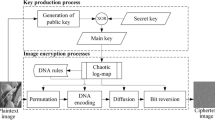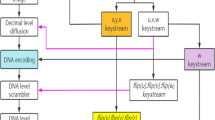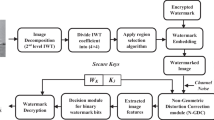Abstract
Transform techniques generally are more robust than spatial techniques for watermark embedding. In this paper, a color image watermarking algorithm based on fractal and neural networks in Discrete Cosine Transform (DCT) domain is proposed. We apply fractal image coding technique to obtain the characteristic data of a gray-level image watermark signal and encrypt the characteristic data by a symmetric encryption before they are embedded. We then use neural networks and Human Visual System (HVS) to embed the watermark in the DCT domain. A Just Noticeable Difference (JND) threshold controller is designed to ensure the strength of the embedded data adapting to the host image itself entirely. Aiming at misjudging problem of the extracting process, maximum membership principle criterion is selected for identifying the watermark. And the CIELab color space is chosen to guarantee the stability of the results. The simulation results show that the algorithm is robust for common digital image processing methods as attacks and that the quality of the image is retained.
















Similar content being viewed by others
References
Barni M, Bartolini F (2004) Watermarking systems engineering: enabling digital assets security and other application. Marcel Dekker, New York
Barni M, Bartolini F, Cappellini V, Piva A (1998) A DCT domain system for robust image watermarking. Signal Processing 66(3):357–372
Cox IJ, Doerr G, Furon T (2006) Watermarking is not cryptography. Lecture notes in computer science, vol 4283. Springer, Berlin, pp 1–15
Cox I, Miller M, Bloom J (2002) Digital watermarking. Morgan Kaufman, San Francisco
Fu X, Wang L (2005) Data dimensionality reduction with application to improving classification performance and explaining concepts of data sets. International Journal of Business Intelligence and Data Mining 1(1):65–87
Haykin S (1999) Neural networks: a comprehensive foundation, 2nd edn. Prentice Hall, New Jersey
Jacquin AE (1992) An image coding based on a fractal theory of iterated contractive image transformations. IEEE Trans Image Process 1(1):18–30
Kang X, Huang J, Shi YQ, Lin Y (2003) A DWT-DFT composite watermarking scheme robust to both affine transform and JPEG compression. IEEE Trans Circuits Syst Video Technol 13(8):776–786
Khan A, Tahir SF, Majid A, Choi T-S (2008) Machine learning based adaptive watermark decoding in view of anticipated attack. Pattern Recogn 41:2594–2610
Lee CH, Lee YK (1999) An adaptive digital image watermarking technique for copyright protection. IEEE Trans Consum Electron 45(4):1005–1015
Nikolaidis N, Pitas I (1998) Robust image watermarking in the spatial domain. Signal Processing 66(3):385–403
Podilchuk CI, Zeng W (1998) Image adaptive watermarking using visual models. IEEE J Sel Areas Commun 16(4):525–539
Tao B, Dickinson B (1997) Adaptive watermarking in the DCT domain. ICCASP’97, Munich, pp 2985–2988
Wang YW, Doherty JF, Van Dyck RE (2002) A wavelet-based watermarking algorithm for ownership verification of digital image. IEEE Trans Image Process 11(2):77–88
Wang LP, Fu XJ (2005) Data mining with computational intelligence. Springer, Berlin
Watson AB (1993) DCT quantization matrices visually optimized for individual images, vol 1913. Proceeding of SPIE conference on human vision, Visual processing and digital display, London, pp 202–216
Acknowledgment
This research is supported in part by the National High Technology Research and Development Program of China under Grant 2007AA01Z324, in part by Natural Science Foundation of Shaan Xi Educational Committee under Grant 08JK319. Any opinions, findings and conclusions or recommendations expressed in this material are those of the authors and do not necessarily reflect the views of the foundations.
Author information
Authors and Affiliations
Corresponding author
Additional information
This work is partially supported by the National High Technology Research and Development Program of China under Grant 2007AA01Z324, the Natural Science Foundation of Shaan Xi Educational Committee under Grant 08JK319.
Rights and permissions
About this article
Cite this article
Mao, L., Fan, YY., Wang, HQ. et al. Fractal and neural networks based watermark identification. Multimed Tools Appl 52, 201–219 (2011). https://doi.org/10.1007/s11042-010-0467-5
Published:
Issue Date:
DOI: https://doi.org/10.1007/s11042-010-0467-5




